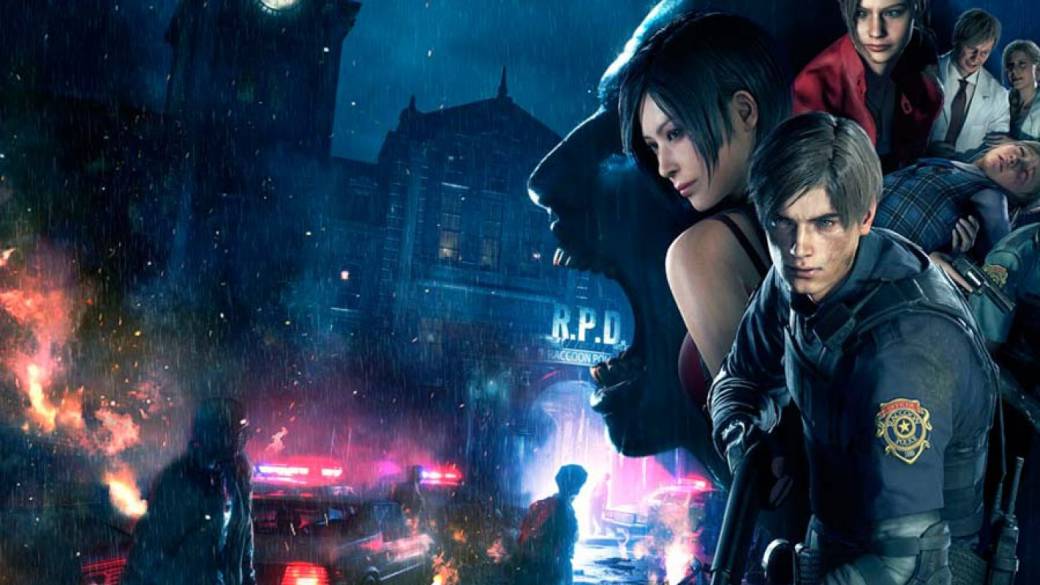
As a prelude to the premiere of the Resident Evil 3 remake, we examined Capcom's history by inventing and reinventing the first installments of the saga.
With the release of Resident Evil 3 on Friday, Capcom will have achieved a new milestone in between. Because this remake is not only a promising game on its own, or the sequel to our chosen GOTY of 2019. It is also the second conclusion of a trilogy that cemented the very concept of Survival Horror and then reimagined it and continue raising the bar in the following generations. It is a unique case, which makes the Raccoon City chapter one of the most important written in any saga or genre. So before we put an end to it by running around its streets in front of the even more terrifying new version of Nemesis, let's take a few minutes to dissect and understand how Capcom has reinvigorated the same formula through multiple sequels and remakes.
Also add, before beginning, that the text will be free of plot guts, since our object of study will be, above all, the playable components. That said, we assume that the reader will have at least some familiarity with the deliveries discussed – specifically Resident Evil (1996 and 2002), Resident Evil 2 (1998 and 2019), and Resident Evil 3 (1999) – although we will try to be somewhat meticulous explanations for the sake of clarity.
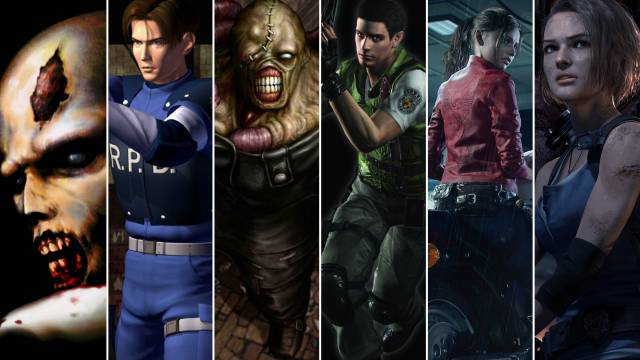
The Basics: Exploratory Keys, Tapes, and Loops
The original Resident Evil is a game for which there are usually plenty of presentations, but before we jump between the other installments there is no need to establish the foundations and its importance for everything that came after. Initially planned as a remake of Sweet Home (oh, the irony), during development it evolved into a very differentiated proposal that deserved its own name. In charge of Shinji Mikami, he pushed forward his ideas and those of Alone in the Dark – another key step in the conception of Survival Horror -, materializing a work whose design lessons are still valid more than two decades later. And right there is where we are going to start unrolling the skein, since the virtues (or potential shortcomings) of the upcoming Resident Evil 3 will be better understood if we are clear beforehand about how the 1996 game works.
To do this, we will first focus on two key elements that, of course, are not the only ones that define Resident Evil, but they do provide the basic pillars to support Survival Horror as an exploratory adventure and not just a scare festival: the design of levels and resource management. Both work as a team and feed each other, conditioning the way in which the player confronts them thanks to a bridge formed by the progression items. These are responsible for opening new areas or access to other items that in turn will do so, progressively expanding the playing field and, by extension, exposure to both enemies and finite goods (consumables) to face them, heal us or even save the game. The grace is that all of them, from keys to ammunition, through the emblematic ink ribbons, occupy space in an extremely limited inventory (of six or eight boxes depending on the chosen character), forcing frequent visits to the rooms with interconnected trunks around to which the design rotates.
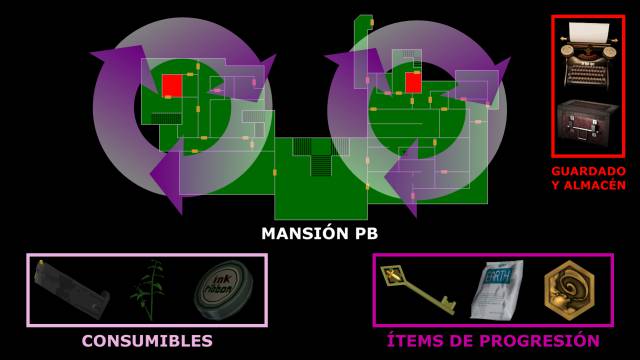
Like its divisive control in relation to the character and not the player – a consequence of the fixed camera system that allowed pre-rendered backgrounds with a high level of detail and paranoia due to lack of vision – the severe restrictions on the inventory created an exploration loop. very sui generis, potentially frustrating and at the same time essential to shape the experience. For the player, the inability to pick up or drop items at the most inopportune times, or to know which ones would be needed during the raid in a newly opened area, added a strong extra pressure to the margin of the enemies. And for developers, this dependence on trunks also increased the requirement in design, since it had to withdraw to never leave too many rooms away from our position and the closest warehouse, as well as effectively differentiating dozens of rooms to facilitate creation of mind maps that reduce as much as possible the need – or rather, frequency of use – of virtual maps to orient oneself.
This, in addition, also resulted in a rich design, with multiple routes and even simultaneous objectives. In the following image we can see the opening phases of the Spencer mansion between the start and the exit to the back garden. Everything marked in green in the left box is accessible after the first encounter with a zombie, which means that much of the mansion is already explorable and the player can reach the sword key (1) or the chemical (2 ) depending on the direction in which you decide to explore. Both items are located in the wardrooms of each wing of the mansion, so once achieved they not only provide new objectives (unlock doors, find the source for the chemical), they also restart the exploration loop from a Safe place to go back to manage inventory or save progress.
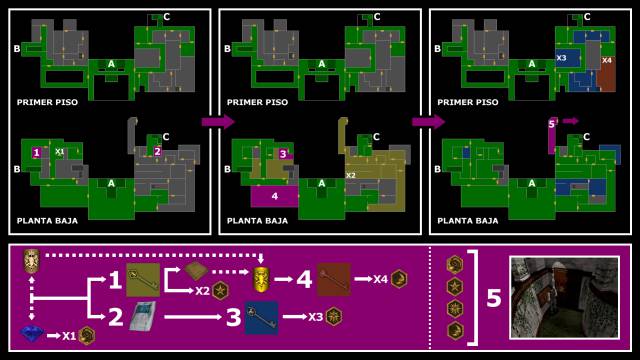 Click to enlarge
Click to enlarge
From there, the game again offers two options depending on whether we first use the chemical to obtain the armor key (3) in the greenhouse or if thanks to the sword key we solve the piano puzzle and the emblems to obtain the shield key (4) in the dining room. After completing both procedures, all areas accessible during the first visit will already be open in order for us to locate the four blazons (X) – also in any order – and unlock the exit to the garden (5). Obviously, as can be deduced by the permanence of some gray rooms or the absence of the basement, this does not cover even half of the development. And also not all the game adheres to this same kind of structure (we will return to the topic later). However, this stretch perfectly encapsulates Survival Horror in its purest form: intricate, yet flexible. Here the saga was conceived, and here it reached a level that still places the original among its best exponents.
Resident Evil 2002: The Perfect Remake?
Following the success of the first Resident Evil, many games both inside and outside the saga revised this formula, although naturally the closest interpretations are found both in its immediate 1998 sequel and, above all, in its 2002 remake. Directed by New for Mikami, the GameCube title was a reconstruction from the ground up that substantially improved graphics, control, script, and dubbing, in addition to adding new puzzles, zones, defensive actions, or enemy routines, among other things. Long and long has been written about its virtues, which exalt it as the quintessential remake. But the truth is that although the result is a potentiated version that at first glance seems to leave the original obsolete, when we delve deeper we discover a better understood work alongside its inspiration, which softens for novices and at the same time subverts for fans. The design is similar and maintains the objective of finding three keys to access the four items that unlock the rear garden, but already from minute one there are differences in weight.
 Click to enlarge
Click to enlarge
The percentage of available starting rooms is considerably lower, as it wants to “push” us towards two of the new areas: a connection between the ground floor and the first floor located in the extreme west, which leads en route to the arrowhead (1) to then enable the two addresses in future uses; and a small cemetery attached to the main vestibule with entrance to a crypt that requires the arrowhead to obtain the sword key (2) and discover that now the four main objects – masks instead of blazons – must be introduced here to get the new emblem that opens the garden. After this many of the original areas, including the two rooms with a trunk (indicated in red), are accessible, but the expectations continue to be played by changing the location or function of items such as the chemical product, not necessary to achieve the armor key. This is almost immediately reachable in a corridor that rises from the room of the arrowhead, but when it is picked up it activates a trap, so we are forced to participate in a chain of events with a whistle, dogs and a counterfeit that the replaces.
Taking that into account, and that none of the masks – or the shield key – is accessible until we have the armor key, it is clear that REmake has a somewhat more linear development. However, this does not have to be negative despite the connotation that such a term usually acquires. Relative linearity is a luxury that the game allows itself because the design has other events or discoveries in which to participate with more flexibility (such as the parallel search for blazons, now useful to achieve the magnum) and in the long run it also takes more advantage of the Mansion. One of the big turning points in the original was its repopulation with reptilian creatures called Hunters, who completely disrupted any sense of confidence upon our return. REmake is faithful to that tradition, but it goes ahead and already uses false familiarity against us during the first stay: the undead zombies open doors to move to adjoining rooms, altering our navigation plans; and the defeated yeses, unless their head explodes or we burn their corpses, come back to life in the form of fearsome Crimson Heads.

In this way, something more guided begins, but as we go through its bottlenecks it escalates with new dangers, inconveniences (after a couple of uses, one of the busiest doors stops opening in one direction due to the breakage of the knob), problems of management through the use of kerosene or shotgun shells (multiply the possibilities of decapitation), and even fragments the return in two visits (this time the final laboratory connects more directly) with added objectives and new opportunities of choice. On the other hand, and already heading towards the next stop, a sequential development can also facilitate more original situations than taking keys and looking for the appropriate locks. As in the case of the chemical to poison a plant, the replica kept on a dog's leash serves to introduce a small episode with its own logic and narrative, different from what was seen in the original title and in the rest of the remake itself. . And becoming, therefore, a memorable part that helps to better define the experience without betraying the most basic rules that support the game.
RE2: That the rhythm does not stop, do not stop, no
Now we do a little pirouette and jump towards an intermediate time between the two versions of the first Resident Evil. Released a couple of years after the original, Resident Evil 2 was a blazing success and, for both media and gamers, a natural evolution of Mikami's classic genre-defining. He got higher notes, sold more copies and although in these cases there is hardly such a thing as unanimity, there does seem to be a certain consensus that he rose as the best in the trilogy even though the following year he faced the other sequel that we will talk about later. To explain this, which of course does not come out of nowhere, nor is it limited to the best graphic finish or small adjustments in the control product of experience, we have to change our focus on level design a bit. We'll also take a quick look at the opening section for a little more context – and in case anyone is curious – but from now on we'll focus on three other elements of increasing importance: climbing, rhythm and replayability.

The escalation takes up a bit of what was discussed about Hunters and Crimson Heads, the use of new situations and dangers to prevent the player from adjusting and the experience gradually losing intensity. It is a phenomenon that occurs throughout the same game, but also when planning a sequel that will reach people who have completed the previous installment once or several times. Needless to say, this does not mean that you start at a level of demand similar to the one that ended the previous one, desensitization is sometimes even combated by lowering the difficulty to focus more on the show. Luckily this is not the case for RE2, or at least not as dramatically as other later exponents of the saga: the start in the middle of the streets of Raccoon City, with burning vehicles and a handful of zombies around us is an effective declaration of intent on the greater magnitude of the conflict, but the game increases enemies and resources in a fairly proportional way to have more action without detracting from the importance of management.
Lickers' introduction as soon as he arrives at the police station –instead of returning like the Hunters– is another example of the small adjustment in philosophy that also gives us the opportunity to talk about rhythm. Because while the building denotes the influence of RE1 on a two-winged structure built around trunk rooms, the game traces a round-trip itinerary to the basement as part of the initial quest (four chess-themed plugs). Like REmake, RE2 opts for narrower bottlenecks, although it uses them to create a lightweight development, where exploration continues to have a strong presence, but the player moves through more acceptable blocks and with a greater narrative load to reinforce short-term objectives. term. In a way, the police station merges the design type of the mansion with that of later sections such as the guest house or the caves, tied together to promote cohesion and backtracking (sometimes to the point: it is hard not to see the slippage) from the third floor clock to the basements as a shortcut for the player and the developers themselves).
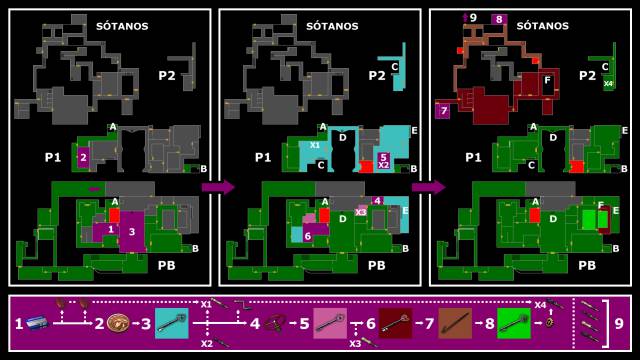 Click to enlarge
Click to enlarge
As a result, RE2 has a less open structure than RE1, but also more control over the variety and intensity of its content, and it is something that works in its favor in terms of replayability. The original will already have two protagonists to choose from, differentiated by the inventory, small playable subtleties (resistance, size of hitboxes) and interactions with other characters that, in addition, could vary between games according to certain decisions – not always aware. RE2 starts from this idea, but the power creating four campaigns with quite different developments due to the exclusivity of events, areas (the image from before is based on "Leon A" and therefore several rooms are inaccessible), bosses or even the real ending . Playing with both Leon and Claire is essential to see the whole story and all the puzzles, but the order is also decisive and creates two parallel "canons" with different entry points to the police station and even the appearance of a new enemy, Mr X, which would teach fundamental lessons for the future of the saga.
RE2 Remake: The X Factor
Released a couple of generations after the remake of the first installment, the reimagining of Resident Evil 2 is, as you might expect, a new Resident Evil for a new era. After the success of reinventions as radical as those of Resident Evil 4 or Resident Evil 7, at Capcom they ruled out going back to the fixed cameras, were somewhat more generous with the inventory and limited the use of tapes to save to the highest difficulty. Since its premature announcement in 2015, the game has become one of the most desired, but also a project about which certain doubts hovered. Luckily, at the moment of truth the team proved to be made up of both highly talented people and fans of a genre that for years –practically from the very first remake– had not been going through its best moment, and they materialized a marriage Almost perfect amid technological advancements, modern conveniences, and painstaking design work aimed at recapturing all the complexities and tension characteristic of Survival Horror into a much more immersive mold. Three lustrums later, the king had returned.
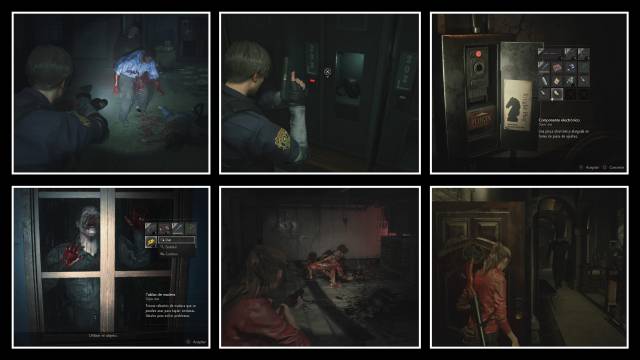
Beyond the monumental improvement in graphics and control, the game uses lighting – or lack of it – in the service of its setting, surround sound to locate dangers, uninterrupted movement between rooms to lighten the exploration – or lean out to watch cautiously – and the change of perspective to rethink resource management: zombies are more resistant, but the amount of bullets does not inflate to make it a Shooter, so it is vital to aim at the head – there is even a system of critics regulated from the retina – or some limb to cause mutilation that reduces its mobility. Some idea of the original RE2, such as upholstering windows that would later become an entry point for new zombies, was also converted into full-fledged mechanics, and also incorporates defensive items and the most unpredictable nature of enemies in REmake, changing rooms included, or gunpowder to create different types of ammunition in RE3.
In terms of design, both the R.P.D. as the later areas are reconstructed from their foundations with new rooms, connections and puzzles. Although the distinction between scenarios suffers somewhat in the process (this time playing Leon A and Claire B, or vice versa, encompasses almost all the content), the development takes enough licenses to condense more events in each game. The search for chess plugs, for example, moves to much more intricate sewers, and a detonator previously only used by Claire is now a common item. Speaking of which, the police station maintains two exploratory blocks separated by a visit to the basement, but each has its own collection, more flexibly structured, and the second is spiced up by the appearance of a Tyrant in a raincoat (nicknamed Mr. X ) that follows us incessantly. This is where the elements are intertwined into a harmonious whole – use of sound to detect it, knowledge of design to plan escape routes, rewarding the foresight to cover windows to find fewer obstacles, etc. – and the game reaches an early but very climax. intense.
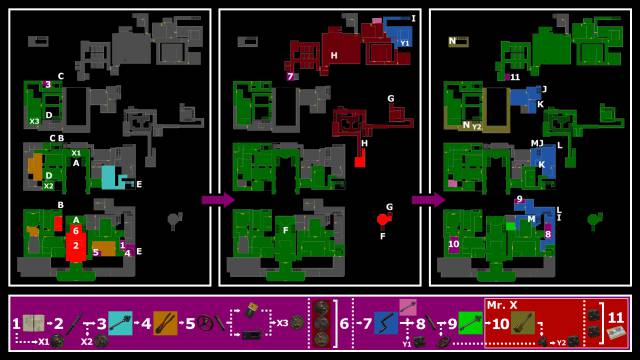 Click to enlarge
Click to enlarge
Despite small concessions and legacy ideas – at times it may recall a “big hit” in the series – in a post-RE6 world RE2 Remake's renewed commitment to Survival Horror is more inspiring than ever. The scripted show again gives way to organic situations, where the player takes or loses control based on his knowledge of systems and design. Where management matters, and where different routes or tactics can be tested in different games. Although after passing the police station Mr. X gives us a break, the game continues to press with the G Adults (the absence of spiders hurts, but mechanically the benefit is more than evident), the new and improved Birkin mutations or the rethinking of the zombie-plant. Although the ideas of the original RE2 are always present, as a reimagination it pushes the limits much more than the previous remake and consolidates a second golden age for the saga that now creates high expectations about its continuity in the remake of the third installment. Speaking of which …
RE3: Terror on the streets
Surely every fan has ever heard that Resident Evil 3: Nemesis was born as a spin-off and reverted to main delivery mid-development. The initial intention was to create a light adventure, starring a group of mercenaries making their way through Raccoon City in the midst of a zombie apocalypse. As we all know, then the plan changed and the final game is somewhat different, as the last few months were spent pushing it towards a channel more similar to that of RE1 and RE2. However, the result still betrays its origin and makes RE3 a title that under a conservative facade houses some of the most interesting ideas in the saga. The first and most evident is the urban approach, which during the start changes the large building with two wings and multiple floors for a network of streets. This does not mean it is an open world, but the premise has a clear impact on the design, simpler, horizontal and also with more bottlenecks.
 Click to enlarge
Click to enlarge
In terms of objectives to be met, the development does offer quite a bit of freedom, especially after reaching the tram located at the other end of the city. So far, the itinerary is made up of a series of small sections with self-contained exploration, much in the style of what is usual in the second half of previous deliveries or later in this one. But once all of them have been overcome, the game proposes to go back and locate four items –three if we already get the first one on the way– to start said tram. As an idea it's a witty twist upon returning to the original Spencer Mansion: We first got acquainted with each zone separately and then re-explored the entire city with new objectives, events, and a couple of extra areas. However, not having a design as branched as its predecessors somewhat limits the possibilities of backtracking, less flexible with round-trip routes than with the order to undertake each search.
The good news is that RE3 proposes substantial changes beyond this reconsideration in exploration – welcome despite its possible shortcomings due to its contrast with the predominance of closed spaces until then. Here of course it's time to talk about Nemesis, which picks up Mr. X's witness and becomes such a pervasive threat that it earns a place in the title. Powered version of the Tyrant, Nemesis runs, fires a bazooka, and reappears frequently even after leaving the urban core. Most of the bouts are optional, although by knocking it out we get items and peace of mind. At other points it does act as boss to use and must be defeated, or it activates special events (“Live Selection”) where an interface makes us choose between options with different consequences. This leads us to another interesting idea, and it is the way in which RE3 fights the absence of two campaigns with a multitude of variations, be it through these scripted events, others more subtle or even some generated randomly.
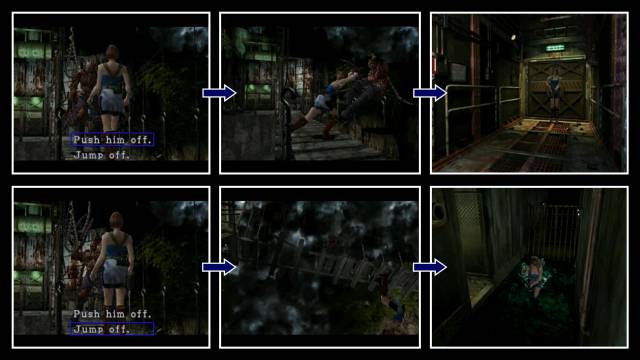
Thanks to this amalgam of systems we can interact with the mercenaries Carlos and Nicholai in different places, begin to explore some of the later areas from different rooms, solve puzzles with variable solutions again or even find different weapons, resources or enemies in rooms with a assigned rotation. Considering that RE3 gives more weight to combat, with new evasive actions, gunpowder to create ammunition on demand, more aggressive zombies, an increase in both the number and variety of creatures, the distribution of explosive objects around the map for your Strategic use and the already discussed Nemesis, the result is not only a more intense development in the minute by minute, but also with added doses of unpredictability that reward adaptability. As traditional Survival Horror RE3 may not finish standing up to his peers, but as a lighter and arcade interpretation of the Resident Evil formula it is a very meritorious effort – especially knowing its origin -, which managed to shorten the distance between terror and action without leaving the genre.
How the new remake will take advantage of this legacy is something that we can all see from Friday. Although if you want to know our opinion, you just have to come back here this afternoon to read their Reviews.

